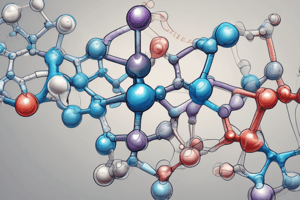Podcast
Questions and Answers
What percentage of the cell's dry weight is composed of proteins?
What percentage of the cell's dry weight is composed of proteins?
- Two-thirds (correct)
- One-quarter
- One-third
- Three-quarters
What is the role of prothrombin and fibrinogen in the body?
What is the role of prothrombin and fibrinogen in the body?
- Maintaining skin and bone structure
- Helping in blood clotting (correct)
- Defending the body against diseases
- Regulating body temperature
What is the building unit of protein?
What is the building unit of protein?
- Nucleic acids
- Fats
- Carbohydrates
- Amino acids (correct)
What happens to proteins when they are treated with acids or bases?
What happens to proteins when they are treated with acids or bases?
What is the primary structure of a protein?
What is the primary structure of a protein?
What is the quaternary structure of a protein?
What is the quaternary structure of a protein?
Which of the following elements are found in proteins?
Which of the following elements are found in proteins?
What is the function of camaglobulin?
What is the function of camaglobulin?
What type of amino acids are essential for the Xanthoprotic reagent experiment?
What type of amino acids are essential for the Xanthoprotic reagent experiment?
What is the aim of the experiment using ninhydrin?
What is the aim of the experiment using ninhydrin?
What is the color of the nitro compounds formed when the amino acid is heated with Concentrated nitric acid?
What is the color of the nitro compounds formed when the amino acid is heated with Concentrated nitric acid?
What is added to the test tube containing the protein in the Xanthoprotic reagent experiment?
What is added to the test tube containing the protein in the Xanthoprotic reagent experiment?
What is the pH range in which ninhydrin is a strong oxidizing substance?
What is the pH range in which ninhydrin is a strong oxidizing substance?
What is the basis of the experiment 'Precipitation of proteins by acids'?
What is the basis of the experiment 'Precipitation of proteins by acids'?
What is the purpose of adding sodium hydroxide solution in the Biuret reagent experiment?
What is the purpose of adding sodium hydroxide solution in the Biuret reagent experiment?
What is the resulting compound formed in the Biuret reagent reaction?
What is the resulting compound formed in the Biuret reagent reaction?
What is the result of adding an acid that carries an amount of negative charges to a protein?
What is the result of adding an acid that carries an amount of negative charges to a protein?
What happens when more acid is added to the albumin in the 'Precipitation of proteins by acids' experiment?
What happens when more acid is added to the albumin in the 'Precipitation of proteins by acids' experiment?
What is the purpose of adding copper sulphate in the Biuret reagent experiment?
What is the purpose of adding copper sulphate in the Biuret reagent experiment?
What is the color formed when a protein reacts with the Biuret reagent?
What is the color formed when a protein reacts with the Biuret reagent?
Which of the following amino acids do not provide detection with the Biuret reagent?
Which of the following amino acids do not provide detection with the Biuret reagent?
What is the name of the complex formed in the Biuret reagent reaction?
What is the name of the complex formed in the Biuret reagent reaction?
Flashcards are hidden until you start studying
Study Notes
Proteins
- Proteins are the most important and complex vital compounds in cells, making up two-thirds of a cell's dry weight.
- They have multiple functions, including:
- Playing a major role in all vital activities
- Being involved in the structure of membranes, muscles, and tissue
- Helping to defend the body through camaglobulin
- Helping in blood clotting through prothrombin and fibrinogen
- Proteins are composed of elements such as sulfur, hydrogen, nitrogen, phosphate, iron, zinc, carbon, oxygen, and copper.
Amino Acids
- Amino acids are carboxylic acids with an amino group attached to an alpha carbon atom.
- Amino acids differ depending on the group R.
- Proteins are decomposed into their constituent amino acids when treated with acids or bases.
- Amino acids are linked to each other by a peptide bond.
Structural System of Protein Molecules
- The structural system of protein molecules has four levels:
Primary Structure
- Sequence of amino acids in the peptide chain
- Can be open, circular, or branched
Secondary Structure
- Consists of helical structures and bent plate structures
Tertiary Structure
- Spherical or oval shape resulting from bending of the spiral structure
Quaternary Structure
- Regularly folded or single folded structures combining to form a quaternary structure
Detection of Proteins and Amino Acids
- Ninhydrin Reagent
- Detects proteins and amino acids
- Reaction depends on the amine group (NH2) and the carboxyl group (COOH)
- Resulting color is blue
- Biuret Reagent
- Detects proteins based on the presence of two or more peptide bonds (C-NH4)
- Results in a violet color
- Xanthoprotic Reagent
- Detects amino acids containing an aromatic ring
- Reaction involves nitration of the benzene ring
- Results in yellow or orange color
- Precipitation of Proteins by Acids
- Based on the property of protein as an amphoteric acid
- Acids with negative charges neutralize the positive charges carried by the protein, forming salts that are deposited at the bottom.
Studying That Suits You
Use AI to generate personalized quizzes and flashcards to suit your learning preferences.



